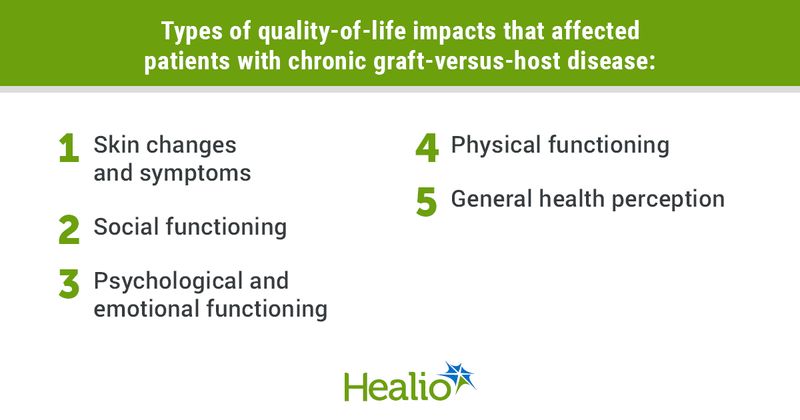Researchers define quality-of-life domains for chronic graft-versus-host disease
Key takeaways:
- Impairment of social life was listed as an ongoing quality-of-life impact for every patient.
- Psychological and emotional functioning was also cited as the most noticeable impairment across disease subgroups.
Researchers found a direct relationship between cutaneous chronic graft-versus-host disease and health-related quality-of-life domains that are not currently included as measurements in clinical trials, according to a study.
“Chronic graft-versus-host disease (GVHD) is a multisystem syndrome and the leading cause of morbidity, mortality and impaired health-related quality of life (HRQOL) following allogeneic hematopoietic cell transplant,” Emily Baumrin, MD, MSCE, assistant professor of dermatology and director of the Graft-versus-host Disease Subspecialty Clinic at Perelman School of Medicine at the University of Pennsylvania, and colleagues wrote. “The objective of this study was to perform concept elicitation to define HRQOL in cutaneous chronic GVHD using patient input and compare the lived experience of disease between patients with epidermal and sclerotic disease manifestations.”

The cross-sectional concept elicitation study included a semi-structured interview and free-listing systematic interviewing session to determine HRQOL impact. The Smith salience index score determined saliency for each term in the free-listing session.
There were 31 adult participants (median age, 61.1 years; 54.8% men) with cutaneous chronic GVHD, nine of which had epidermal GVHD, 13 with sclerotic GVHD and nine with a combination of the types.
The authors found 40 items that were significant impacts to patients’ quality of life. These 40 items were grouped within five groups and included skin changes and symptoms, social functioning, psychological and emotional functioning, physical functioning and general health perception.
Sixty-five percent of patients reported dry skin as one of the most frequent symptoms followed by tight skin (61%), itchiness (48%) and discoloration (45%). According to the study, these symptoms were present in every disease subtype.
Impairment of social life was listed as an ongoing quality-of-life impact for every patient. Psychological and emotional functioning was also cited as the most noticeable impairment across disease subgroups and included frustration (Smith salience index score, 0.32), worry or concern (Smith salience index score, 0.12) and discomfort (Smith salience index score, 0.2).
The researchers also found that certain environmental factors would affect the impact that skin changes and symptoms had on a patient’s quality of life. These environmental factors included social comparison, illness comparison with cancer, anatomic location of disease involvement and disease duration.
For example, a patient with combination disease who compared their skin disease with cancer stated, “All this other stuff as far as I’m concerned, it doesn’t mean anything to me. I survived. Some discomfort is better than not being here.”
Another patient with sclerotic disease referenced anatomic location as a factor for their quality of life, stating, “I healed a patch of [GVHD] on my face, and when that initially happened, I was really scared about it, but now it’s not in an area for me where I feel it hinders my life in any way.”
As a result, the authors emphasized that patient-reported outcomes are an important measure for therapeutic efficacy and efforts should be made to develop a disease-specific patient-reported outcomes measurement tool that includes the impacting factors outlined in this study for future GVHD clinical trials.
